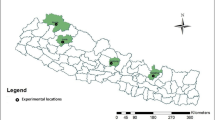Summary
Both reciprocal averaging and discriminant analysis confirm visual impressions that covered and naked barleys from several areas in the Himalaya differ significantly from each other in a multivariate way. Discriminant analysis also suggests similar differences between the ‘occidental’ and ‘oriental’ barleys of Takahashi (1955). Either distinction has implications for our understanding of barley phylogeny and evolution.
Similar content being viewed by others
References
Baum BR (1983) Morphometric relationships in Hordeum vulgare (Triticeae, Poaceae). 2. Hordeum agriocrithon, H. lagunculiforme, H. spontaneum, and H. vulgare. Can J Bot 61:2023–2031
Baum BR, Bailey LG (1983) Morphometric relationships in Hordeum vulgare (Triticeae, Poaceae). 1. H. spontaneum. Can J Bot 61:2015–2022
Freisleben R (1940a) Die phylogenetische Bedeutung asiatischer Gersten. Der Züchter 12:257–272
Freisleben R (1940b) Die Gersten der deutschen Hindukusch-Expedition 1935. Kühn-Archiv 54:295–368
Hill MO (1973) Reciprocal averaging: an eigenvector method of ordination. J Ecol 61:237–249
Hull CH, Nie NH (1981) SPSS update 7–9: new procedures and facilities for releases 7–9. McGraw-Hill, New York
Murphy PJ (1982) Primitive cereals and their wild relatives. PhD Thesis, University College of North Wales, Bangor
Murphy PJ, Witcombe JR (1981) Variation in Himalayan barley and the concept of centres of diversity. In: Asher MJC, Ellis RP, Hayter AM, Whitehouse RNH (eds) Barley genetics, vol. IV. Editorial sub-committee, 4th Int Barley Genet Symp, Edinburgh, pp 26–36
Nie NH, Hull CH, Jenkins JG, Steinbrenner K, Bent DH (1975) SPSS, Statistical package for the social sciences, 2nd edn. McGraw-Hill, New York
Nilan R (1964) The cytology and genetics of barley 1951–1962. Washington State University Press, Pullman, Washington
Rao AR (1974) Genecology of Nepalese cereals. PhD Thesis, University College of North Wales, Bangor
Takahashi R (1955) The origin and evolution of cultivated barley. Adv Genet 7:227–266
Takahashi R, Hayashi J, Hiura U, Yasuda S (1968) A study of cultivated barleys from Nepal Himalaya and North India with special reference to their phylogenetic differentiation. Ber Ohara Inst Landwirtsch Biol, Okayama Univ 14:85–122
Witcombe JR (1974) University College Bangor Nepal Expedition 1971: Report of the Genetic Conservation Project. University College of North Wales, Bangor
Witcombe JR (1975a) Cereals in Nepal. FAO (Rome), Plant Genet Resources Newslett 31:19–28
Witcombe JR (1975b) Bangor Lyallpur Universities Expedition to Northern Pakistan 1974: Genetic Conserv Rep. University College of North Wales, Bangor
Witcombe JR (1978) University College Bangor Expedition to Northern India 1976: Genetic Conserv Rep. University College of North Wales, Bangor
Witcombe JR, Murphy PJ (1986) Covered and naked barleys from the Himalaya. 2. Why do they differ from each other so extensively? Theor Appl Genet 71:736–741
Author information
Authors and Affiliations
Additional information
Communicated by R. Riley




